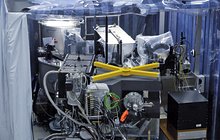SPHERE
Spectro-Polarimetric High-contrast Exoplanet REsearch instrument
One of the most challenging and exciting areas of astronomy is the subject of ongoing research at ESO's Paranal Observatory: the search for exoplanets — new worlds orbiting other stars. To help in this task, an instrument was carefully planned and, after years of studies and construction, installed on Unit Telescope 3 of the Very Large Telescope (VLT): SPHERE or the Spectro-Polarimetric High-contrast Exoplanet REsearch instrument.
SPHERE is a powerful planet finder and its objective is to detect and study new giant exoplanets orbiting nearby stars using a method known as direct imaging — in other words, SPHERE is trying to capture images of the exoplanets directly, as though it were taking their photograph. SPHERE can also obtain images of discs of dust and debris around other stars, where planets may be forming. In either case, direct imaging is extremely hard to do.
 More than a thousand exoplanets have been discovered since the 1990s, but only a very few have been detected directly. For example, HARPS, another successful planet finder, uses indirect techniques to find planets by determining radial velocity variations.
More than a thousand exoplanets have been discovered since the 1990s, but only a very few have been detected directly. For example, HARPS, another successful planet finder, uses indirect techniques to find planets by determining radial velocity variations.
One major obstacle to directly imaging a distant exoplanet is that the light of any star is so powerful from our point of view that something close to it, like a planet orbiting the star, is swamped by the starlight. SPHERE blocks out the central region of the star to reduce its contribution — this type of instrument is called a coronagraph, and is used (as the name suggests!) to study the outer layers of the Sun. But have you ever tried to block the sunlight with your thumb? If you have, then you will probably have noticed a blinding ring of light around your shadowed finger.
SPHERE is designed to exploit a clever way of suppressing the stellar light contribution. It turns out that the light emitted naturally by stars (including the Sun) is unpolarised, meaning that the electromagnetic waves oscillate randomly in different directions. But when light is reflected by a surface (such as a planet or a dusty disc), the reflected waves are partially polarised, which means that they now oscillate in a well-defined plane. Polarised sunglasses exploit this property: they block the polarised light reflected from the surfaces around us, yielding a crystal-clear view with high contrast and much reduced glare. But SPHERE is looking to pick out the polarised signal — and it’s also possible to isolate this using special filters. “The polarimetric differential imaging mode of SPHERE works on this principle: the light emitted by the central star is unpolarised, but the light scattered by the dusty disc is polarised, so we can use this difference to isolate one from the other and get a very sharp view of the disc itself,” says Juan Carlos Muñoz, previously an ESO astronomer at the VLT.
So there are three important stages in extracting the direct image of a planet. First, a state-of-the-art adaptive optics system has been incorporated into the instrument to correct for the turbulent effects of the Earth’s atmosphere with the aim of delivering images as sharp as if the telescope were floating in space. Secondly, a coronagraph is used to block out the light from the star itself and increase the contrast still further. Finally, a technique called differential imaging is applied that exploits differences (the filters) between planetary and stellar light in terms of colour or polarisation. The light from the star is blocked out, leaving only the planet — although in practice the process is not as straightforward as this overview suggests!
The instrument is equipped with 3 subsystems:
- ZIMPOL is a special purpose camera, that can both make very sharp images and measure polarisation in visible light and the near infrared (from 600 to 900 nanometres). Its role is to detect the reflected polarised light of gaseous planets orbiting very close to their host stars, and detect the scattered light from the dusty discs around young stars. It uses a unique trick to detect very faint objects around very bright stars.
- IRDIS is a camera working at near-infrared wavelengths, from 900nm to 2.3 microns, whose main goal is to image young self-luminous giant planets thanks to advanced observational strategies based on a technique called differential imaging.
- IFS is a near-infrared integral field spectrograph that can work simultaneously with IRDIS to provide a spectrum at each given location of the field of view. This enables astronomers to characterise the composition of the atmosphere of giant planets.
Science highlights with SPHERE
- SPHERE reveals dusty discs surrounding nearby young stars in greater detail than previously achieved (eso1811)
- Protoplanetary discs revealed being shaped by newborn planets (eso1640)
- SPHERE used to explain how giant star is losing mass so quickly (eso1546)
- Unique structures spotted around nearby star (eso1538)
- SPHERE reveals earliest stage of planetary nebula formation (eso1523)
SPHEREThe authoritative technical specifications as offered for astronomical observations are available from the Science Operation page.
|

